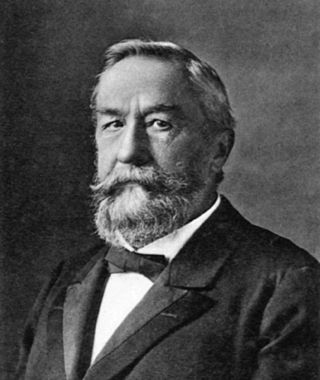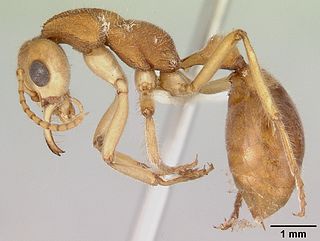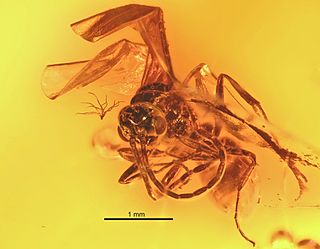
Gustav L. Mayr was an Austrian entomologist and professor in Budapest and Vienna. He specialised in Hymenoptera, being particularly known for his studies of ants.

Aphaenogaster is a genus of myrmicine ants. About 200 species have been described, including 18 fossil species. They occur worldwide except in South America south of Colombia, sub-Saharan Africa, and Antarctica.

Baltic amber or succinite is amber from the Baltic region, home of its largest known deposits. It was produced sometime during the Eocene epoch, but exactly when is controversial. It has been estimated that this forested region provided the resin for more than 100,000 tons of amber. Today, more than 90% of the world's amber comes from Kaliningrad Oblast of Russia. It is a major source of income for the region; the local Kaliningrad Amber Combine extracted 250 tonnes of it in 2014 and 400 tonnes in 2015.

Prionomyrmex is an extinct genus of bulldog ants in the subfamily Myrmeciinae of the family Formicidae. It was first described by Gustav Mayr in 1868, after he collected a holotype worker of P. longiceps in Baltic amber. Three species are currently described, characterised by their long mandibles, slender bodies and large size. These ants are known from the Eocene and Late Oligocene, with fossil specimens only found around Europe. It is suggested that these ants preferred to live in jungles, with one species assumed to be an arboreal nesting species. These ants had a powerful stinger that was used to subdue prey. In 2000, it was suggested by Cesare Baroni Urbani that the living species Nothomyrmecia macrops and a species he described both belonged to Prionomyrmex, but this proposal has not been widely accepted by the entomological community. Instead, scientists still classify the two genera distinctive from each other, making Nothomyrmecia a valid genus.

Prionomyrmecini is an ant tribe belonging to the subfamily Myrmeciinae established by William Morton Wheeler in 1915. Two members are a part of this tribe, the extant Nothomyrmecia and the extinct Prionomyrmex. The tribe was once considered a subfamily due to the similarities between Nothomyrmecia and Prionomyrmex, but such reclassification was not widely accepted by the scientific community. These ants can be identified by their long slender bodies, powerful stingers and elongated mandibles. Fossil Prionomyrmecini ants were once found throughout Europe, possibly nesting in trees and preferring jungle habitats. Today, Prionomyrmecini is only found in Australia, preferring old-growth mallee woodland surrounded by Eucalyptus trees. Nothomyrmecia workers feed on nectar and arthropods, using their compound eyes for prey and navigational purposes. Owing to their primitive nature, they do not recruit others to food sources or create pheromone trails. Nothomyrmecia colonies are small, consisting of 50 to 100 individuals.

Agroecomyrmex is an extinct genus of ants in the formicid subfamily Agroecomyrmecinae, for which it is the type genus. The genus contains a single described species, Agroecomyrmex duisburgi. Agroecomyrmex is known from a group of Middle Eocene fossils which were found in Europe.

Aphaenogaster amphioceanica is an extinct species of ant in the subfamily Myrmicinae known from a single possibly Miocene fossil found in amber on Hispaniola. At the time of description A. amphioceanica was one of two Aphaenogaster species known from the Caribbean islands.

Aphaenogaster mayri is an extinct species of ant in formicid subfamily Myrmicinae known from a series of Late Eocene fossils found in North America. A. mayri was one of two Aphaenogaster species described in a 1930 paper by Frank M. Carpenter.

Aphaenogaster longaeva is an extinct species of ant in formicid subfamily Myrmicinae known from a solitary Eocene or Oligocene fossil found in North America. A. longaeva was one of five insect species described by the paleoentomologist Samuel Hubbard Scudder in an 1877 paper.

Aphaenogaster oligocenica is an extinct species of ant in the subfamily Myrmicinae known from a pair of Middle Eocene fossils found in Europe. A. oligocenica is one of three species in the ant genus Aphaenogaster to have been noted from fossils found in Baltic amber by William Morton Wheeler.

Aphaenogaster mersa is an extinct species of ant in the subfamily Myrmicinae known from a pair of Middle Eocene fossils found in Europe. A. mersa is one of three species in the ant genus Aphaenogaster to have been noted from fossils found in Baltic amber by William Morton Wheeler.

Asymphylomyrmex is an extinct genus of ants in the formicid subfamily Formicinae. The genus contains a single described species, Asymphylomyrmex balticus and is known from a group of Middle Eocene fossils which were found in Europe.

Electrostephanus is an extinct genus of crown wasp in the hymenopteran family Stephanidae, and is the only genus placed in the subfamily Electrostephaninae. The genus contains four described species, E. brevicornis, E. neovenatus, E. janzeni, and E. petiolatus, placed in two subgenera E. (Electrostephanus) and E. (Electrostephanodes). Electrostephanus is known from several middle Eocene fossils which have been found in Europe.

Yantaromyrmex is an extinct genus of ants first described in 2013. Members of this genus are in the subfamily Dolichoderinae of the family Formicidae, known from Middle Eocene to Early Oligocene fossils found in Europe. The genus currently contains five described species, Y. constrictus, Y. geinitzi, Y. intermedius, Y. mayrianum and Y. samlandicus. The first specimens were collected in 1868 and studied by Austrian entomologist Gustav Mayr, who originally placed the fossils in other ant genera until the fossils were reviewed and subsequently placed into their own genus. These ants are small, measuring from 4 to 6 mm in length and can be characterized by their trapezoidal shaped head-capsules and oval compound eyes that are located slightly to the rear of the capsules midpoint, with no known ocelli present.

Paraneuretus is an extinct genus of formicid in the ant subfamily Aneuretinae known from fossils found in Asia and Europe. The genus contains three middle to late Eocene age species, Paraneuretus dubovikoffi, Paraneuretus longicornis, and Paraneuretus tornquisti.

Bradoponera is an extinct genus of ant in the Formicidae subfamily Proceratiinae, and is one of four genera of the subfamily. The genus contains four described species Bradoponera electrina, Bradoponera meieri, Bradoponera similis, and Bradoponera wunderlichi. The species are known from several Middle Eocene amber fossils which were found in Europe.

Electromyrmex is an extinct genus of ants in the formicid subfamily Dolichoderinae. The genus contains a single described species, Electromyrmex klebsi and is known from a group of Middle Eocene fossils which were found in Europe.

Pachycondyla succinea is an extinct species of ant in the formicid subfamily Ponerinae described from fossils found in Europe. P. petrosa is one of three middle Eocene Pachycondyla species found in Baltic amber.

Nylanderia pygmaea is an extinct species of formicid in the ant subfamily Formicinae known from fossils found in the Prussian Formation of the Baltic region.
The Prussian Formation, previously known as the Amber Formation, is a geologic formation in Prussia, today mostly Kaliningrad Oblast that dates to the Eocene. It holds 90% of the world's amber supply and Baltic amber is found exclusively in the Prussian Formation.



















